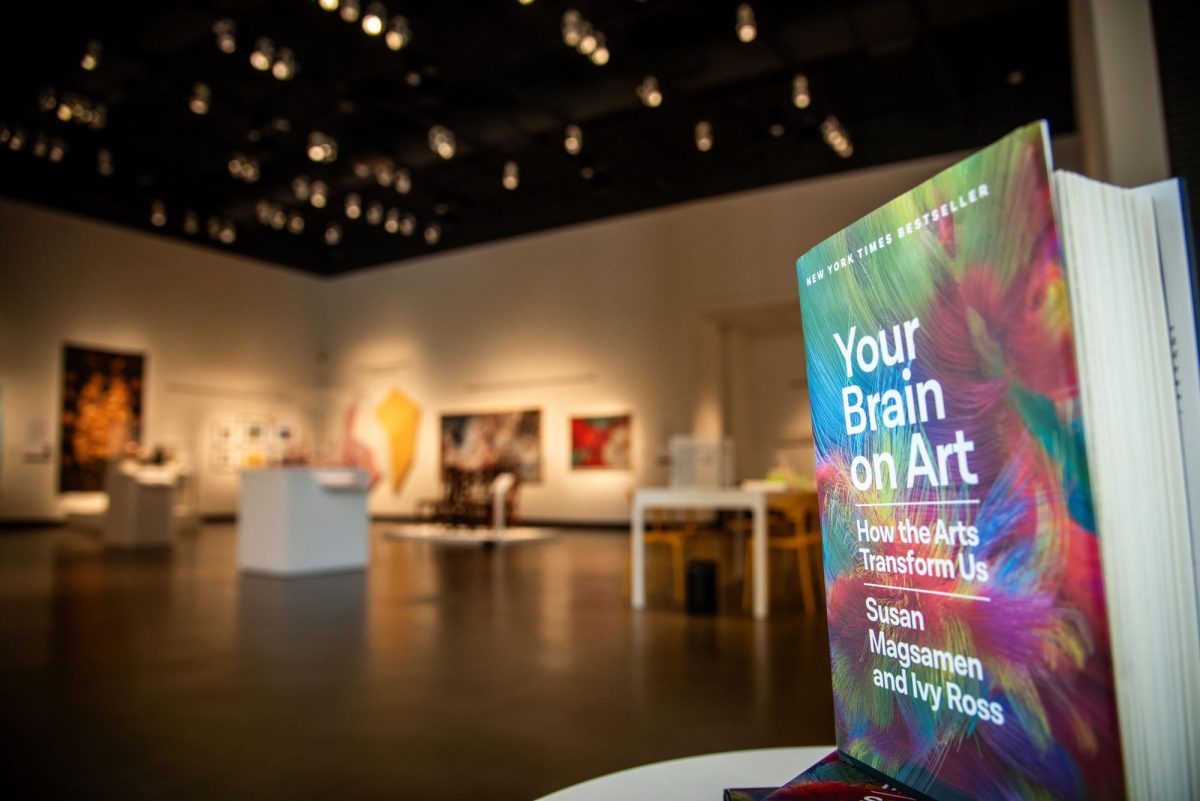
Alex Manuel
Susan Magsamen and Ivy Ross’s best-selling book, “Your Brain on Art: How the Arts Transform Us,” sits in front of the exhibition in the Gregg Museum of Art and Design on Friday, Sept. 12, 2025. The exhibit positions artwork around quotes from the novel.
“Your Brain on Art: Reimagining the Gregg Museum Collection” guides patrons through a variety of artistic pieces, each thematically connected to the findings of Susan Magsamen and Ivy Ross’ best-selling book, “Your Brain on Art: How the Arts Transform Us.”
Visitors explore ideas of wellness while learning about the body’s complex physical and psychological connection to the arts. Locally created pieces of furniture, ceramics, film, paintings and more are displayed alongside quotes from the book to create a compelling narrative.
Sara Segerlin is the director of the Gregg Museum and oversees exhibitions and programming. She joined the team in 2024 to implement a more collaborative and interactive approach to museum work.
“My goal is to help the Gregg Museum become a social space, but also a place of restoration and a place of belonging,” Segerlin said.
She wanted this show to exemplify these values and encourage a sense of wellness and belonging. Having worked with Magsamen and Ross before, Segerlin found their book to be the perfect way to facilitate conversation and create a nuanced exhibit.
The exhibition was curated with the help of six NC State faculty members, including John Meitzen, John Godwin, Alper Bozkurt, Valeria López Torres, Gavin Bell and Victoria Ralston. They represent a diverse variety of specializations, from neuroscience to graphic design. After reading the book, they chose pieces and quotes for the exhibit that provide unique insight from their respective fields.
Segerlin enlisted the help of these faculty members to ensure a variety of experiences were represented, especially given the collection’s complex and interdisciplinary nature.
Valeria López Torres, an assistant professor of graphic and experience design, spoke about her time on the curatorial team. She said they worked hard to find a cohesive narrative among their ideas.
“You have the neuroscientist, the designer and the psychologist. All of these people who apparently move in different worlds, but in reality, we all are anchored in what it means to be human,” Torres said. “Art is part of what it means to be human. It is not tied to a degree. You don’t have to have a degree in arts to experience and appreciate art.”
The collection is arranged around the perimeter of an open space, with prominent quotes on the walls guiding the thematic narrative. Playing on a nearby TV is the documentary “Brush Strokes,” which follows 75-year-old Larry Harper as he rediscovers his passion for art with the support of his daughter Lakisha Harper-Bradley. The film reflects on his upbringing in the segregated South, paying tribute to his resilience and the power of art to connect people.
Another display houses three ceramic pieces spanning several decades. Senora Lynch’s “Your Hands Can Heal” draws on her indigenous tradition and creates a beautiful scene of hands overlapping with stars and plant life.
Above the ceramics, a quote from “Your Brain On Art” reads: “Sculpting with clay has been found to alter our brain-wave activity in such a way as to induce a calmer and more reflective state.”
Tamara Velasco is the education coordinator for the Gregg Museum. She arranges tours and programming at the museum and creates interactive activities that engage visitors.
“The old way of looking at museums was just to have someone tell you what to learn,” Velasco said. “We really want to encourage people to do more critical thinking with hands-on activities and engagements.”
Whether you’re seeking a new perspective, an interdisciplinary lens or a sense of well-being, this collection invites visitors to discover and engage with the intersection of art and the brain.
“Your Brain on Art: Reimagining the Gregg Museum Collection” will be open until Sept. 27. You can keep up with upcoming events at the Gregg by following their Instagram @ncstategreggmuseum or checking out their website.